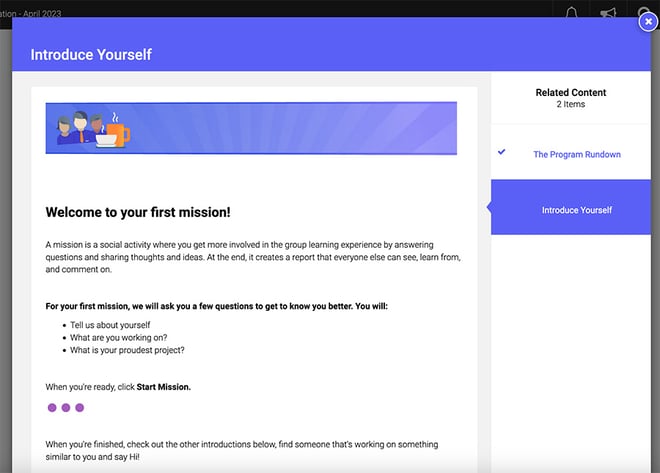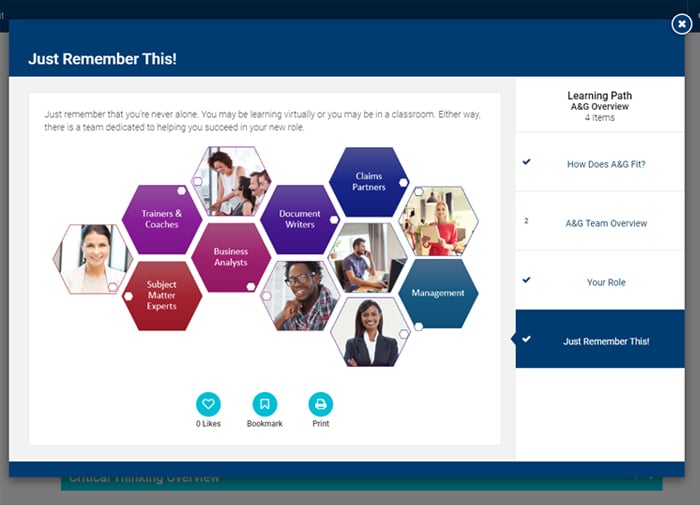As labor shortages, talent retention challenges, and the rise of remote work continue to reshape the corporate landscape, onboarding plays a crucial role in determining an organization's success.
A recent study revealed that Generation Z, now a growing force in the workplace, craves a tailored, digitally-focused, and interactive onboarding experience. Miss this mark, and organizations might face an unsettling uptick in early turnover among these fresh faces – a cost that can quickly amount to 33% of an employee's annual salary.
But how can forward-thinking CLOs navigate this terrain? You may have encountered the widespread view that onboarding is merely a routine process to get new hires up and running. Yet, the dynamics of onboarding have evolved significantly. Integrating new team members is no longer just an administrative task; it's a key factor influencing employee motivation and, ultimately, business growth.
To help you tackle this complex task, we'll explore eight onboarding best practices to make every employee's induction experience not just functional but transformative, both for them and the business.
What is onboarding?
Employee onboarding is the strategic process through which new hires seamlessly integrate into a company. As the backbone of an employee's journey, it sets the stage for them to become proactive and engaged team members. Unlike a brief orientation, where one might simply watch a video and fill out forms, onboarding dives deeper, bridging the emotional and practical connections between an individual and the organization.
In short, onboarding lays the foundation for a new hire's transition into their:
- Job role
- Work processes
- Relationships, and
- Company culture.
In the age of remote onboarding, this process has taken on new dimensions, ensuring that remote team members feel as included and valued as their in-office counterparts. The broader shift to flexible and hybrid work models has heightened the need for effective onboarding methods that cater to diverse employees' styles and preferences, regardless of their location, while maintaining a consistent culture across all touchpoints. Realizing this potential hinges on seeing onboarding as an immersive experience rather than a one-time event.
But before considering the top onboarding practices that foster such memorable journeys, let's explore the benefits of this process in more detail.
Key benefits of an effective onboarding experience
As we witness a broader demographic shift, with 21% of Millennials now rotating roles within a single year, onboarding can't be just a checklist. Addressing distinct generational expectations across diverse cultures, backgrounds, and experience levels requires innovative solutions.
One promising avenue is the blended learning model. Merging the best of all modalities, it intertwines synchronous and asynchronous sessions by offering a mix of real-time and self-paced learning options. This effective onboarding strategy enables both general and role-specific training, allowing new hires flexibility in their learning journey, complemented by virtual instructor-led training (VILT) events.
Our employee onboarding case study with a health insurance call center is particularly illuminating. The company switched from an 18-week, fully in-person training program to Intrepid's blended onboarding approach, and the results were impressive. Here are some of the benefits the client discovered:
- Consistent employee engagement and excitement across diverse roles and geographies, with a heavy focus on applied learning that resulted in a 30% increase in learner satisfaction scores
- Shortened onboarding cycle time by more than 15% and quicker time-to-proficiency from nine months to six weeks, leading to several million dollars in annual savings
- Swift role adoption across varied positions
- Enhanced instructor productivity with reduced teaching and administrative time
- Global training availability, unhindered by hire count or location
Indeed, the benefits of streamlined onboarding are clear. But what steps can organizations take to work towards the best employee onboarding experiences?
8 onboarding best practices to enhance the employee experience
A robust onboarding process is vital for ensuring sustained employee engagement and productivity. The following strategies are drawn from successful onboarding strategies, contemporary research, and industry leader insights. They aim to address the modern workplace's complexities and put the learner at the heart of the onboarding experience.
So, here are our top recommendations.
1. Extend a heartfelt welcome and introduce yourself to new employees
If first impressions could speak, what would yours say? Beginning an employee's journey with a genuine, heartfelt welcome in text or video form sets a powerful precedent for their experience. Not merely a nice gesture, this initial outreach signals that the company values its members and is invested in their cultural integration.
You can also create a collaborative “Introduce Yourself” Mission in the Intrepid platform, for instance, to create an immediate connection between the facilitator or moderator and learners, as well as between the learners themselves, to ignite a spark of camaraderie and lay the foundation for a profound sense of belonging. This connection enhances employee morale and plants the seeds for long-term loyalty and collaboration within the organization.

An example of an "Introduce Yourself" Mission.
2. Promote growth opportunities within organization and role
Research tells us that when career growth opportunities align with expectations, knowledge workers don't just work – they thrive, forging deeper ties with their organizations. This bond translates to enhanced employee retention.
The foundation of this bond begins with cultural immersion and a strong focus on organizational values. When employees see the company's vision aligning with their aspirations, it fosters deep commitment. It's no longer just about acquiring skills or climbing the ladder. It's about being part of a story, weaving the values and missions of the organization into one's own career trajectory.
Dedicated avenues for role readiness and professional development also strengthen an employee's commitment. Clear pathways to role proficiency and future growth opportunities on the front lines signal mutual respect. It conveys the message: "We recognize your potential and are here to support your growth."

UnitedHealthcare's award-winning Medicare Appeals & Grievances onboarding program has a strong focus on ongoing support, collaboration, and feedback through its entirety to help new hires grow and succeed within the organization.
3. Facilitate peer connections through a "learning buddy" system
In the dynamic landscape of professional development, fostering peer connections is a strategic move that goes beyond traditional mentorship. Introducing a 'learning buddy' system during the onboarding process can significantly enhance the new hire experience. Unlike mentors, learning buddies are often peers or professionals at a similar or slightly higher level, creating a collaborative learning environment where knowledge flows freely in both directions.
The value of collaborative learning lies in its ability to cultivate a culture of shared insights and mutual growth. Pairing new hires with colleagues who may be at an equal or slightly advanced career stage encourages the exchange of diverse perspectives and skills. For example, envision a scenario where a junior developer is paired with a colleague who has recently navigated a similar learning curve. This relationship allows the new hire to benefit from the seasoned professional's experiences, while the experienced colleague gains fresh insights and perspectives from the newcomer's innovative approach.
The 'learning buddy' system not only accelerates the onboarding process but also lays the foundation for an ongoing culture of collaborative learning within the organization, fostering continuous professional development for all employees.
4. Prioritize ruthless relevance with action-oriented learning content
Ruthless relevance in learning hinges on content that immediately connects with a learner's day-to-day tasks and challenges, ensuring that what they engage with is directly applicable and impactful in their work. Without clear objectives, new hires may find themselves adrift in a sea of information. In this age of digital content overload, the last thing they need is another listless journey through generic modules.
Send the learner out into the field to learn from others, find information on company sites, learn about customers, etc. Ask them to "go do" rather than just read stuff passively. In Intrepid, there are features such as missions, projects, and assignments that allow new hires to practice new skills immediately and apply them to their actual work context. As they complete these tasks in their onboarding experience, they can improve through a blend of human and AI-driven feedback.
When UnitedHealthcare redesigned one of its onboarding programs to focus on applied learning, they saw average NPS scores increase from 35% to 72% and a shortening of time-to-proficiency from nine months to six weeks. It's a win-win for both the employee and organization.

Here's a sample of one of UnitedHealthcare's case practice assignments in Intrepid for learners to complete, with gamification incorporated in the form of points earned to increase learner motivation and engagement.
5. Centralize onboarding resources for easy access and efficiency
Imagine a learning experience where all your onboarding needs are just a click away – that's the power of a centralized hub like Intrepid's learning platform. Merging resources into one unified system simplifies the experience and maximizes its impact. Here's what this approach offers:
- Consistency, Scalability, and Flexibility: Standardized onboarding regardless of location
- No Login Chaos: Save time, reduce learner frustration with one login versus many
- Efficiency: One-stop-shop reduces missed info
- Collaboration: Interactive features foster peer learning
- User Engagement: Intuitive platforms increase usage
- Reporting: Easy monitoring for swift adjustments
A central learning hub ultimately accelerates integration, fosters collaboration, and boosts performance.
6. Use spaced learning principles to spread good onboarding practices out over time
Spaced learning taps into our brain's innate rhythm, enhancing memory and skill acquisition through well-timed intervals. This approach, which is part of the AGES model, particularly shines when combined with "on-the-field" activities, allowing practical application to reinforce theoretical understanding.
Create a time-released learning experience that spaces learning over time, encouraging steady learner engagement and steering away from last-minute cram sessions. Tactics like spaced quizzes, automated email reminders, and ongoing projects or missions encourage ongoing participation, reinforcing crucial concepts and skills.
In our previously mentioned employee onboarding case study, for instance, the spaced learning approach led to consistent engagement, a reduction in onboarding time, enhanced instructor productivity, worldwide training accessibility, and accelerated role adoption, collectively contributing to successful onboarding outcomes. Organizations can use this principle to enhance traditional training, creating a dynamic onboarding process that seamlessly blends theory with practice for lasting impact.
7. Boost employee engagement through gamification
Who doesn't enjoy a good challenge – especially when it's wrapped up in an exciting game format? Integrating gamified elements into onboarding can be the key to supercharging learner motivation. When learning becomes an interactive quest, it engages the mind, triggers curiosity, and and motivates new hires to actively participate and achieve milestones.
Game mechanics like points, levels, a leader board, and badges offer immediate feedback and visual milestones, serving as compelling reminders of progress. So, consider integrating interactive challenges and gamification into your onboarding journey to transform the mundane into the memorable with an engaging and positive tone.

An example of a leader board and badges within Intrepid to engage and motivate new hires to participate and achieve milestones.
8. Use data-driven insights to refine the employee onboarding process
The idea of measuring workplace learning early in the onboarding process may seem odd – after all, shouldn't we focus on just welcoming new hires rather than assessing them? Yet, while initial warmth is vital, a deeper understanding from the get-go sets the stage for success.
Data-driven insights offer a precise lens to gauge the effectiveness of employee onboarding strategies. By monitoring learner progress and interactions with course content, filtering against key metrics like time-to-competency, and getting granular insights at cohort and individual levels, companies can pinpoint areas for enhancement and ensure every employee feels competent and connected from day one.
Combat onboarding challenges by meeting a new hire’s "5 Moments of Need"
While good onboarding practices set the tone, it's the real-time, in-the-moment support that truly resonates with new hires and addresses their day-to-day challenges. Conrad Gottfredson and Bob Mosher's "5 Moments of Need" framework provides a lens through which this support can be structured:
- New: Imagine the first-day jitters of a new customer service agent. Amidst the excitement, they dive into a comprehensive onboarding session to understand their new role. The challenge amplifies when onboarding remote employees, but a tailored virtual experience ensures their success. Engaging digital modules, community forums, and instant access to reference tools keep them closely connected with the company's essence.
- More: Curiosity can steer us toward further understanding. Say an HR professional wishes to refine recruitment strategies. Anticipating this need, the company should stand ready with advanced resources or mentoring sessions that enrich their understanding, helping them master nuances beyond the basics.
- Apply: When it's time to implement newfound knowledge, real-world application is key. In this arena, practical tests, missions, and/or simulated scenarios with AI video coaching can be invaluable. For instance, they could enable a new sales representative to apply product knowledge, perfecting their pitch without the high stakes of an actual client meeting.
- Solve: Challenges are an inevitable part of the journey. When a marketing executive encounters a hiccup not covered during onboarding, they can rely on readily available troubleshooting guides or seek assistance from peer forums. This immediate support helps overcome hurdles and transforms them into valuable learning opportunities.
- Change: As the corporate landscape evolves, adaptability isn't just a virtue – it's a necessity. With changes in company policy or the introduction of new tools, timely update sessions or micro-modules can bridge the knowledge gap and keep every team member in the loop.
Key takeaways: a roadmap for onboarding best practices
Onboarding in the modern workspace has shifted from a mere administrative task to a strategic investment in employee development. Central to this evolution is the need for a tailored, digitally-focused approach that addresses the preferences of emerging generations and seasoned professionals alike. To meet these diverse expectations, organizations should consider innovative solutions like blended learning models, offering flexibility and scalability, and use technology to track progress and support collaboration.
Are you seeking a learning solution that seamlessly integrates the best onboarding practices with the latest technology? With Intrepid's collaborative learning platform, new hires are empowered, swiftly integrated, and immersed in your company's ethos from day one.
Book a demo and enhance your onboarding approach, ensuring a transformative first experience that will build the foundation for motivated, productive, and retained employees.
Frequently asked questions about onboarding best practices
What is employee onboarding?
Employee onboarding is the strategic process through which new hires seamlessly integrate into a company. It lays the foundation for a new hire's transition into their job role, work processes, relationships, and company culture.
What are employee onboarding best practices?
Eight onboarding best practices to enhance the employee experience include:
- Extend a heartfelt welcome to new employees
- Promote growth opportunities within organization and role
- Facilitate peer connections through a "learning buddy" system
- Prioritize ruthless relevance with action-oriented learning content
- Centralize onboarding resources for easy access and efficiency
- Use spaced learning principles to spread good onboarding practices out over time
- Boost employee engagement through gamification
- Use data-driven insights to refine the employee onboarding process
false LOREM IPSUM TITLE






 Previous
Previous